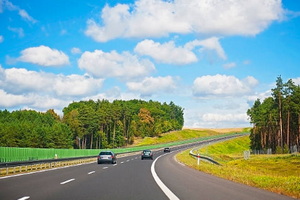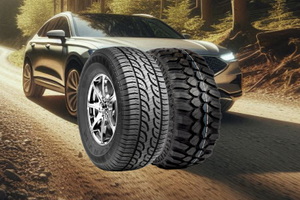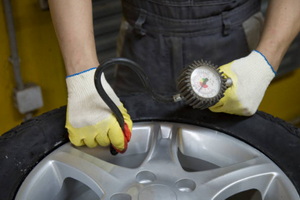News
Does Your Driving Style Affect Joyroad Tire Lifespan?

You know that friend who changes tires every six months and blames “bad luck”? Yeah, it’s not luck – it’s driving habits. Fast starts, sharp turns, and braking like they’re in a Fast & Furious sequel can all add up to premature tire doom. The good news? With smarter driving, you don’t need to replace tires faster than your socks.
Yes, your driving habits absolutely affect tire life – like how binge-watching TV affects your social life. Aggressive acceleration, harsh braking, and corner-cutting aren’t just fun ways to feel like a race car driver – they’re sneakily shaving years off your tires. If you treat the road like a calm Sunday stroll instead of a rollercoaster, your tires will thank you by living longer. So, gentle starts, coasting to stops, and fewer donut-shaped tire marks in the parking lot can actually save you cash (and embarrassment at the tire shop).

Keep reading to find out if your daily commute is nurturing your tires – or destroying them one pothole at a time.
1.Does aggressive driving kill your tires faster?
Aggressive driving puts your tires in survival mode
Absolutely. If your driving style would make a stunt double nervous, your tires are waving little white flags. Aggressive driving – rapid acceleration, sudden braking, and fast cornering – is thrilling but brutal on tire rubber.
Heat buildup speeds up rubber degradation
When you slam the brakes like a caffeine-charged squirrel, your tires heat up fast. Heat softens rubber. And soft rubber wears quicker. That’s basic tire physics – think of it like sliding on hot butter.
Hard acceleration leads to uneven wear
Also, when you accelerate hard (like you’re drag racing a grocery cart), more force transfers to the tires. This causes uneven wear, particularly in front-wheel-drive vehicles. You may even notice feathering or cupping. No, that’s not a massage – it’s irregular tire wear that feels like petting a hedgehog the wrong way.

Joyroad tires are strong, but not superhero-strong
Joyroad performance tires are built for handling power, but even the best rubber can’t outlast overly dramatic driving. If you’re the type who treats yellow lights as a personal challenge, maybe ease off just a bit. Your tires – and wallet – will thank you.
Smooth driving saves money and extends tire life
Transitioning to smoother driving helps distribute the stress more evenly across the tread. You’ll enjoy longer tread life and better fuel efficiency. Not to mention, you might actually hear your music over the squeals.
2.Can slow, steady drivers really extend tire life?
Smooth and steady wins the tire race
Yes, they absolutely can. While it’s not as glamorous as zooming past people on the freeway, slow and steady drivers are basically giving their tires a gentle spa day.
Gentle braking reduces wear and tear
Easing into stops instead of stomping the brakes helps avoid sudden heat buildup. That heat? It’s what causes rubber to break down faster. Gentle braking = happier rubber.
Gradual acceleration protects the tread
Accelerating gradually also reduces stress on tread blocks. You’re not throwing your tires into battle every time the light turns green. It’s more like a graceful ballet, minus the tutus.

Joyroad tires last longer with calm driving habits
Joyroad tires, designed for long-lasting performance, respond well to this kinder style of driving. They last longer, roll quieter, and don’t scream in protest every time you change lanes.
Predictable patterns = longer tire health
The wear patterns stay more even too, which is great for your wallet. And possibly your alignment. Plus, the ride feels smoother. You might even notice fewer spilled coffees. Unless you drive with a straw – in which case, carry on.
3.Do city drivers experience faster tire wear?
Stop-and-go living is tough on tread
Oh, city drivers – those noble warriors of the red light. Unfortunately, yes, urban driving is generally tougher on tires. Why? It’s the combo of stop-and-go traffic, tight corners, and the occasional pothole large enough to host a pool party.
Frequent braking wears tires unevenly
Tires wear down faster in the city because they rarely get to cruise. You’re braking often, starting again, and swerving around delivery scooters and mysterious objects on the road.
Short trips keep tires from warming up properly
Also, short commutes mean tires don’t get fully warmed up. Cold rubber wears faster. And with city speeds, tires don’t hit the optimal rolling efficiency that saves wear and fuel.

Joyroad touring tires offer urban durability
Joyroad touring tires are designed with city wear in mind. They handle frequent starts and stops like champs and still maintain grip on rainy days, speed bumps, and the elusive parallel parking maneuver.
Air pressure and rotation are your urban allies
Still, city drivers should check tire pressure more often. Urban driving doesn’t allow tires to “stretch their legs,” so uneven pressure has a bigger impact. And don’t forget tire rotation – it’s not just a mechanic’s small talk topic. It actually helps.
4.Is highway driving easier on tires?
Yes, highways are tread-friendly zones
Good news for long-distance commuters: highway driving is generally easier on tires. Your tires get to roll smoothly at consistent speeds, without the trauma of traffic lights or rogue grocery carts.
Less braking means less heat buildup
The lack of frequent braking means less heat is generated. Tires warm up steadily and stay within optimal temperature ranges, which reduces the risk of rubber breakdown.
Even wear patterns develop over long stretches
Plus, the wear pattern is usually more even. You’re not constantly turning or stopping, so tires wear uniformly across the tread. It’s like giving them a calm, meditative road yoga session.

Joyroad all-season tires love a good cruise
Joyroad all-season tires are particularly happy on highways. Their tread design minimizes rolling resistance while offering dependable grip – especially when the sky decides to open up. They cruise well, corner confidently, and keep the road noise lower than your travel playlist.
But beware of highway hazards
That said, don’t get too cozy. Highway driving has its dangers: high-speed debris, poor lane markings, or overly enthusiastic lane changers. Make sure your tire pressure is ideal, and always double-check alignment if your car starts drifting like it’s auditioning for a racing movie.
Tire balance still matters at high speeds
High-speed cruising amplifies imbalances. A wobbly wheel you barely notice in town feels like a rollercoaster on the expressway. So keep those tires rotated, aligned, and balanced – even if they look fine.
5.Do heavier vehicles shorten tire lifespan?
Weight wears tires like a gym session
Yep. Heavier vehicles put more pressure on tires. It’s like sending them to the gym every time you drive – and not a gentle Pilates class, but full-on tire CrossFit.
More weight = more rolling resistance
Heavier cars, trucks, and SUVs require more energy to get moving and to stop. That extra effort translates to more rolling resistance, which puts extra stress on the tire’s structure.
Uneven wear happens faster
This stress can lead to faster tread wear, especially if tire inflation is off. Underinflated tires on heavy vehicles tend to wear on the shoulders, while overinflated ones center-wear like a bald spot.

Joyroad SUV and LT tires are built for the load
Joyroad’s LT and SUV tires are reinforced to handle more weight. They feature thicker sidewalls and deeper tread grooves to support extra load without giving up performance. But even the strongest tire has its limits.
Proper load ratings matter more than ever
Make sure your tires match the vehicle’s load requirements. Using passenger car tires on a heavy SUV is like asking flip-flops to run a marathon. Comfortable for a second – tragic for the long haul.
Don’t forget tire rotation
Heavy vehicles, especially those with front-wheel drive, can wear out front tires much faster. Regular rotation is essential. Think of it as a spa day for your tired front tires – they deserve a break.
6.Do temperature extremes influence driving style and tire wear?
Hot or cold – the weather does care
Yes, temperature matters. Driving in extreme heat or cold doesn’t just mess with your mood – it messes with your tires, too. And how you drive during these seasons? It makes all the difference.
In the heat: rubber softens, wear speeds up
In hot climates, rubber compounds heat up faster. Aggressive driving in summer can cause tires to overheat, leading to faster tread wear, blowouts, or that burnt-rubber smell you don’t want wafting through your A/C.
In the cold: traction changes, so does behavior
Cold weather makes rubber stiff and less grippy. Sudden moves – like braking too fast or cornering hard – can cause sliding, uneven wear, or icy pirouettes you didn’t sign up for.

Joyroad tires are weather-tested
Joyroad tires are built to handle both ends of the thermometer. Their compounds are designed for flexibility, durability, and road grip – but they still need a driver who knows when to ease up.
Adjust your style with the season
Seasonal adjustments in driving behavior – slower starts in winter, gentler braking in summer – make a big impact on tire health. Like your skin, tires have seasonal needs too.
Mind your tire pressure year-round
And tire pressure? It drops in winter, rises in summer. Check it monthly. It’s free, fast, and prevents your tires from living a double life – worn on the sides, bald in the middle.
7.Does tire maintenance reduce the damage from bad driving?
Yes, maintenance gives your tires a fighting chance
You can’t undo a lifetime of bad driving with a tire rotation, but you can definitely reduce the damage. Maintenance is like flossing – it doesn’t replace brushing, but it helps.
Rotation spreads the wear around
Tire rotation evens out tread wear. Front tires wear faster, especially if you drive like every corner is a slingshot. Moving them to the back gives them time to rest and heal. Sort of.
Alignment keeps you rolling straight
Alignment’s the secret sauce. When your wheels point where they should, tires wear more evenly. Misalignment leads to scuffed treads, weird pulling, and the “why does my car feel like a shopping cart?” effect.

Joyroad tires love a good rotation
Joyroad tires are engineered for balanced wear, but they’re not miracle workers. Even the best design can’t fight camber misalignment or overinflation without your help.
Pressure checks are non-negotiable
Underinflated tires flex more, causing heat buildup. Overinflated ones wear in the center. You want the Goldilocks zone – just right. So yes, grab that pressure gauge. It’s not just a decoration.
Driving habits + maintenance = long tire life
Bad habits do damage, but with solid maintenance, you buy your tires more time. It’s like feeding your goldfish regularly – it doesn’t make it immortal, but it sure helps.
Conclusion
Driving style matters. A lot. Whether you’re smooth or spirited, how you handle your car directly impacts Joyroad tire lifespan. Respect the rubber, stay on top of maintenance, and match tires to your driving habits – you’ll enjoy the ride a lot longer. And with fewer pit stops.





